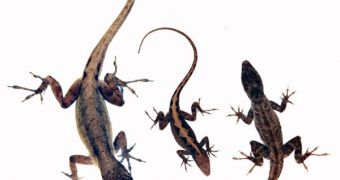In a clear example that illustrates the evolutionary differences between males and females of the same species, researchers backed up by the US National Science Foundation (NSF) have recently discovered a series of genetic inconsistencies between anole lizards, which are endemic to the Bahamas. The investigators say that one of the most interesting aspects of this species is the fact that males differ considerably from females, both in terms of genetic make up and body size, a feat that would otherwise merit a distinct classification of the two genders as different species.
While analyzing the individuals best suited for survival from both genders, the experts also learned that the genes, which make for a “high quality” female – as in one that has the highest chances of survival and reproduction – are considerably different from the ones making for a “high quality” male. In addition, the males were found to be about 200 to 300 percent larger in body size than females, the team reports. Details of the investigation appear in the latest issue of the esteemed publication Science.
The new work was conducted by Dartmouth College biologists Ryan Calsbeek and Bob Cox, who have been studying these lizards for some time. Funding for their study came from the NSF Directorate for Biological Sciences Division of Environmental Biology. “In an evolutionary sense, what's good for the goose is not always good for the gander,” says Cox, who is also the lead author of the journal entry. He adds that a double standard applies in this species, hinting at the fact that evolution favors the survival of larger males and smaller females.
What makes this particular species stand out is the fact that its females appear to have mastered genetic engineering in a sense. They've learned that mating with large males increases their chances of producing male offspring, whereas doing so with smaller males increases the chance of them producing daughters. Generally, high-quality males of all species tend to produce weak daughters, and so at times it may not be in the species' best interest for females to give birth to these offspring. But the anole lizards appear to have exceeded this natural limitation, the team states.
“This species has figured out a clever way to pass on genes with gender-specific effects on fitness. Usually, when natural selection pulls genes in different directions from each gender, the species faces an evolutionary dilemma. But these lizards have solved this puzzle, they've figured out how to get the right genes into the right gender,” Cox reveals. “As we predicted, the survival of the male offspring increased if they had large fathers. But we found that the survival of the daughters was not influenced by the size of the father. This suggests that the genetic benefits of large size are specific to sons,” Calsbeek concludes.

 14 DAY TRIAL //
14 DAY TRIAL //